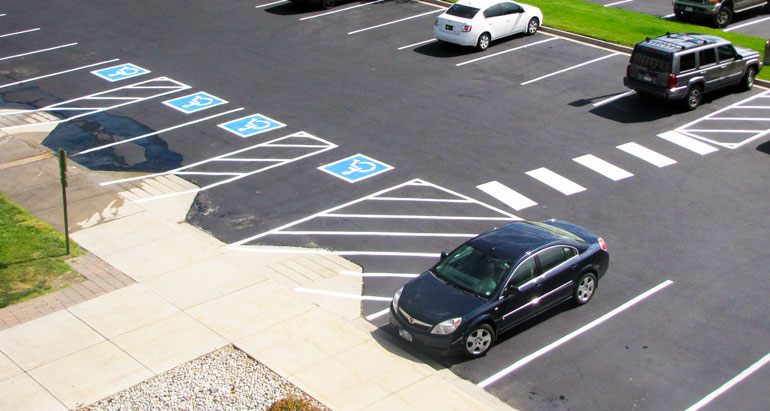
Parking Prohibitions & Restrictions: Illegal Stopping, Standing & Parking
Updated Oct. 20, 2020To understand parking laws and prohibitions, we must first consider all the different ways a driver can stop their vehicle. The rules of the road often make a distinction between these three forms of stopping.
Stopping refers to a driver temporarily bringing their vehicle to a complete stop using the brakes. Drivers may stop to avoid a hazard or to follow instructions given by traffic control devices.
Standing is when a driver stops their vehicle but leaves the engine running and remains behind the wheel.
Parking refers to a driver stopping, switching off the car’s engine and leaving the car.
Understanding the differences between these actions is important. Stopping is permitted in many areas where parking or standing is illegal. Equally, standing may be permitted (for the purposes of loading or unloading), when parking is prohibited.
General rules concerning stopping, standing and parking are explored on this page. While this information applies in most areas, you must still refer to your state’s official driving manual for local rules. Always keep a lookout for regulatory road signs which prohibit stopping, standing or parking near the roadside, as there are many other situations in which these actions are illegal that are not included in this general article.
Illegal parking can incur significant fines for the registered owner of the vehicle. If injury or property damage occur as a result of your improperly parked car, you can expect to be held financially responsible.
Where is stopping illegal?
Drivers must not stop, stand or park under any circumstances when:
- On a sidewalk, crosswalk or any other place where pedestrians have right-of-way
- On a lane reserved for bicycles
- Passing through an intersection
- On railroad tracks at crossings
- On a bridge or overpass
- In a tunnel
- Near excavations or obstructions, on either side of the road
All drivers are expected to know these rules, so there may not be road signs present to indicate that stopping is illegal.
Where is standing illegal?
Standing and parking is generally prohibited in the areas and situations listed below. While you may not stand or park, stopping is usually permitted.
- In front of or blocking a driveway or alley
- Within 15 feet of intersections with unmarked crosswalks
- Within 20 feet of any crosswalk
- Within 30 feet of a traffic light, flashing traffic beacon or “STOP” sign
- Within 50 feet of a railroad crossing
- Within 15 feet of a fire hydrant
- Within 20 feet of a fire station driveway on the same side of the street, or within 75 feet in the opposite side of the street
- Within 500 feet of a collision site when a police officer is present
- Blocking a building’s emergency exit or fire escape
- Outside permitted hours in a place where standing and parking are allowed at certain times of day
- Beside an expired parking meter
- In front of a theater entrance
- Obstructing access to a rural mailbox
Keep in mind that there may be some minor variations in the distances listed here around the United States. Refer to your driving manual for standing restrictions in your state.
Double parking is illegal
Double parking is the illegal practice of standing, stopping or parking between an already parked car at the roadside and the main driving lanes. Double parking is dangerous, as it would mean your vehicle occupying a portion of the roadway reserved for moving traffic. Plus, you may totally or partially block in the other driver next to whom you have illegally parked. Double parking is a traffic violation and is punishable with a fine.
 A vehicle is parked on the roadway side of another parked vehicle. The practice of double parking is illegal across the US and is punishable by a large fine.
A vehicle is parked on the roadway side of another parked vehicle. The practice of double parking is illegal across the US and is punishable by a large fine.Improper use of disabled parking spaces
Parking spaces marked in blue or with wheelchair symbols are reserved for handicapped drivers. Only persons holding a disabled permit (and displaying that permit in the parked vehicle) may occupy a disabled parking space. Keep in mind that the person named on the permit must be using the vehicle for it to legally park in a handicapped space. Do not park in a disabled parking area unless you have a permit. Disabled parking spaces often have more space separating them than ordinary parking spaces, to facilitate easy wheelchair access. These striped areas are off-limits to all vehicles.
 Do not park in striped areas adjacent to disabled parking spaces or in a striped area in front of an entrance to a business adjacent to a disabled parking space. Striped areas are for wheelchair lifts.
Do not park in striped areas adjacent to disabled parking spaces or in a striped area in front of an entrance to a business adjacent to a disabled parking space. Striped areas are for wheelchair lifts.Absence of dedicated parking spaces
Motorists should always use a designated parking spot to park or stop their vehicle, if there is one available nearby. If exceptional circumstances mean that you must stop when no dedicated parking spaces are available (for instance, on a highway or a limited access freeway), adhere to the following rules:
- Make sure your vehicle can be seen. It should be visible to traffic for at least 200 feet in both directions.
- Position your vehicle so that other vehicles have enough space to pass safely.
- Activate your parking lights and/or hazard lights, to draw attention to your stopped vehicle.
Parking safely on a hill
It is your responsibility to ensure your vehicle is properly secured when parking on any hill or slope. Parked cars can roll away and cause devastating accidents, even on very gentle inclines. The parking brake is designed to stop your vehicle from rolling, though they are not always effective. The steeper the hill, the greater chance there is that your parking brake may not work.
In addition to activating the parking brake when parking on a hill, you should position your front wheels in a way that would direct your vehicle toward the curb (or away from traffic) should it begin to roll. Here is a break-down of how to position your wheels when parking on a hill:
- 1

When parked facing downhill, or uphill on a road without a curb, turn your wheels toward the roadside.
- 2

When parked facing uphill on a road with a curb, turn your wheels away from the roadside.
If you do not take every possible measure to safely secure your vehicle on a hill and it rolls away, you will be financially liable for any disruption, property damage, injury or loss of life caused.




